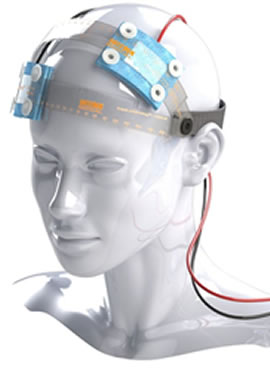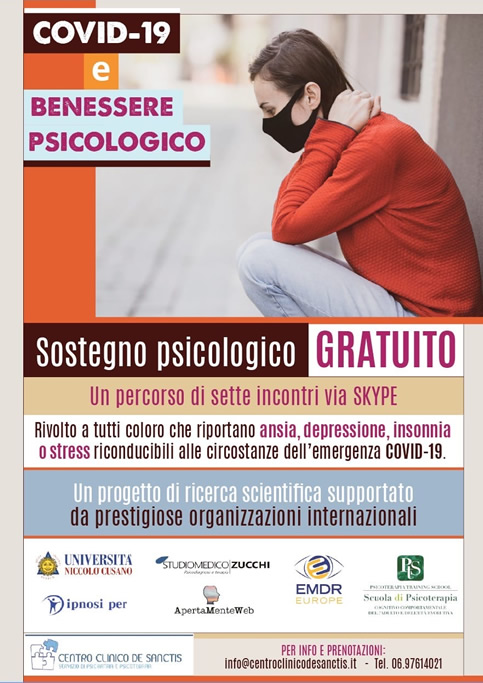




Servizio di Diagnosi e Terapia dell’ADHD Presso il Centro Clinico de Sanctis è presente il Servizio di Diagnosi e Terapia dell’ADHD...
Read moreIl Corso per la riduzione dello stress basato sulla consapevolezza (Mindfulness Based Stress Reduction, MBSR) è un protocollo di intervento...
Read moreEMDR, a sea of possibilities.
17/18/19 June 2016, The Hague, The Netherlands.
After two and a half years of thorough and continuous preparation by the Dutch Conference Committee, it was finally here: the European EMDR Conference in The Hague, The Netherlands! More than 1200 people from 48 countries, and from all continents, signed up for the pre-conference and conference that included 8 inspiring keynote presentations and preconference workshops. In addition, there was 75 other speakers on a wide variety of topics, as well as fifteen posters, that presented today’s most advanced researches and current clinical results in the EMDR field.
In this spirit, the Conference adopted the motto “A sea of possibilities”, a nod to The Hague beautiful sea, as well as to recognize and describe the different applications of EMDR therapy and provide participants with clear and specific guidelines on interventions modalities with different populations, for a variety of symptoms, disorders and mental issues. These issues are linked to stressful situations caused by severe life events and traumatic relational experiences.
Regarding this specific topic, the interesting presentation by Jenny Ann Rydberg, “Demanualizing EMDR”, comes to mind. In this presentation she attempted to answer the two following questions: 1) While demonstrating EMDR's effectiveness and efficacy in the treatment of a large number of mental health issues is a widely shared priority, does the ever-growing number of new protocols really serve that purpose? 2) What is research measuring and what are the core elements of EMDR? Using the concept of "standard variations", Jenny Ann Rydberg discussed the relevance of a wide range of modifications made to the standard procedures and protocols to justify the existence of "special EMDR protocols". She then proposed useful, specific and detailed guidelines on when and why to consider applying each of these standard variations, both for clinical practice and as an object of research.
Of course we can’t mention all the presentations in which expert clinicians showed their work with special populations suffering from specific disorders, but the reader will be able to find them and easily download the abstracts from the website of the conference (www.emdr2016.eu).
I can affirm that the main streams of exploration during the congress were neurobiology, the child development, and the refugees.
The main conference started with a great and amusing performance by the Dutch illusionist Victor Mids. Next, Bruce Perry presented his preconference workshop “Introduction to the Neurosequential Model of Therapeutics”. Then, in his keynote presentation, “The Impact of Trauma and Neglect on the Developing Child”, he talked about the ways in which experiences shape the organization of the brain that, in turn, influences the emotional, social, cognitive, and physiological activities. He provided an overview of the key principles of neurodevelopmental which are crucial for understanding the role of experience in defining functional and physical organization of the brain, the hierarchy of brain development. Finally, he reviewed clinical work and research that can help us better understand developmental trauma, neglect and the relational problems that arise from neglect and intimidation. At the same time, Mark Nickerson in his preconference workshop, “Breaking the cycle: EMDR Therapy solutions for problematic anger, acting out and addictive behaviors”, taught practical strategies and special considerations for a successfully tailored use of the 8-Phases EMDR treatment approach. Violent behavior – recalled Mark Nickerson – is typically a trauma reenactment and reprocessing strategy that can aid patients in undoing the maladaptive template. Trauma-informed interventions offer realistic hope for true transformation and behavioral change. Marco Pagani, brilliant as always, in his workshop for EMDR Supervisors, gave a great review of all contributions demonstrating the neurophysiological changes in the brain functionality, produced by EMDR.
One of the main fields of interest in this conference was surely the applications of EMDR for the therapy of children and adolescents. Barbara Wizansky and Esther Bar Sadeh reminded us how the apparent lack of motivation, the oppositional behavior, or direct fear of meeting painful material – so frequent in childhood and adolescence’s disorders – can be understood as an automatic activation of the developmental defenses of dissociation or avoidance. Carlijn de Roos focused on how to recognize, activate and process the unresolved physical aspects of traumatic memories in children aged 0-4 years who have experienced a so called “preverbal trauma” or were exposed to a “somatic” trauma such as sexual or physical abuse or some kind of intrusive medical treatment. Maria Zaccagnini presented an interesting and useful protocol to intervene in the case of attachment disorders, working with children and their parents.
EMDR therapy is playing a big role working with victims of terroristic attacks, with the refugees and the asylum seekers. This was the focus of a very interesting round table between the journalist Brenda Stoter, Derek Farrell (President of Trauma AID Europe), Rolf Carriere (former Executive Director of the Global Alliance for Improved Nutrition in Geneva) and Isabel Fernandez (President of EMDR Europe and Director of the Italian Association for EMDR) called: “The Refugee Crisis in Europe and Its Implications for EMDR Therapists”. EMDR therapy can make a great contribution to refugees. It can prevent mental disorders, help to resolve risk factors and facilitate integration and adjustment to a new culture while using and transforming the critical experiences that this population is exposed to in a constructive way.
To sum up, the attendees were given the opportunity to take note of the latest applications of, and insights about, EMDR therapy. Almost all of the most important disorders , including Eating Disorders, Phobias, Depression and Mood Disorders, Obsessive-Compulsive Disorders and even Schizophrenia, were the focus of brilliant presentations during the three days Conference.
In particular, the data coming from the research in the field of applications of EMDR in psychotic disorders was quite impressive. In an innovative symposium, David van der Berg and his group (this year’s winners of the Francine Shapiro EMDR Research Award) showed how EMDR can be useful not only for the co-morbid post-traumatic symptoms so often suffered by psychotic patients, but also for the psychotic symptoms themselves, that can be improved by the EMDR treatment. In other words, this data appears as a confirmation of the importance – for any kind of psychopathological disorders – of the post traumatic dimension: it is always present and it is always worthwhile to treat, even in the case of disorders traditionally considered mainly biologic, like schizophrenia and other psychosis.
Some discomfort was evoked by Ad De Jongh, who presented results of a study showing the opportunity of using EMDR in the cases of complex PTSD (cPTSD) directly, without passing through the stabilization phase, as indicated by the ISTSS guidelines.
Regarding this special clinical population, the great majority of the EMDR community shares with the experts of trauma and dissociation the idea of the necessity of a stabilization phase, before being able to access and treat the trauma itself with the BiLateral Stimulations (BLS). Dolores Mosquera and Anabel Gonzales also showed this in their presentations during this annual EMDR Conference.
But perhaps, at the basis of this divergence, could be an important misunderstanding about how to consider cPTSD. Starting from the fact that PTSD is seen by Ad De Jongh as an anxiety disorder (even if it is no longer included among the Anxiety Disorders in the DSM-5), he talked about cPTSD as a simple addition of several different symptoms, as a mere co-morbidity. In other words, only as a more serious form of PTSD because it is associated to other anxiety or mood disorders. So, in the case of cPTSD being considered “PTSD plus another disorder”, the suggestion coming from De Jongh’s study (published in Depression and Anxiety) sounds more logical. He argues that even in case of psychotic disorders it is clinically reasonable to treat the traumatic dimension before any other aspect. But, cPTSD is generally considered different from the way De Jongh described it during his workshop: as a disorder characterized by a very important dissociative dimension, for some aspects near to a personality disorder, stepping from developmental, multiple, prolonged traumas, usually relational, interpersonal are often caused by the same attachment figures.
EMDR therapists, according to the International Guidelines, have always agreed more with the necessity of a stabilization phase (less or more prolonged, depending on the different cases, also here with some always more sophisticated procedures) for the patients suffering from cPTSD and DD, before activating, access and finally process the traumatic episodes. In fact, it is only thanks to these kind of patients that EMDR has progressively been transformed from a technique into a method and then into a more sophisticated and integrated approach while utilizing a series of procedures coming from several theoretical contributions (from the attachment theory to the theory of structural dissociation by Onno van der Hart, Ellert Nijenhuis and Kathy Steele,and colleagues, for example, to the polyvagal theory by Stephen Porges and to the bodily, imaginative and neurophysiological techniques), capable of increasing the “window of tolerance” in the patient, their ability to regulate emotions, and then the possibility to expose them again to the trauma without excessive risks. In this field of applications (how to deal with the “stabilization phase” during an EMDR therapy), the contributions offered during the last few years from expert clinicians in treatment of complex trauma and dissociative disorders like Solomon, Gonzalez, Mosquera are very relevant.
Perhaps what these scholars and De Jongh seem to have in common is to avoid the idea of stabilization meant only as a passive and prolonged listening of the patient from the therapist. Also, De Jongh and his group, in fact, emphasizes the importance of the use of specific strategies – and then an active therapeutic role, also during the first phase of the therapy, when the therapist can begins to use the BLS.
During the days in The Hague, many meetings were held on specific fields of interest and many Committees of the Emdr European Association gathered. In particular, we want remind that the Research Committee assigned many funds for interesting studies all over Europe.
In any case, the evaluations showed that the conference (and of course the beach party on Saturday) were very much appreciated by the participants in The Hague.
Protocollo di Mindfulness per la riduzione dello stress sulla pratica...
Read morePratiche di mindfulness per imparare a stare nella realtà per quella...
Read moreIl programma di riduzione dello stress si è rivelato particolarmente efficace...
Read moreVenerdì 8 marzo 2024 | ore 18,30 - 20,30 Spazio...
Read moreIl corso è rivolto a ragazzi e ragazze con difficoltà...
Read moreCorso di Mindful YogaSpazio settimanale di nutrimento interioreIL CORSO AVRÀ...
Read moreIl master online "Introduzione agli approcci bottom up" è un...
Read moreArriva il Natale, uno dei periodi più belli e attesi...
Read moredi Lucalfredo Di Salvo Se abbiamo accumulato qualche chilo di troppo...
Read morePerchè non dimagriamo? Un articolo di Lucalfredo Di Salvo Parliamoci chiaro, chi...
Read more
La Stimolazione Transcranica a Corrente Diretta (tDCS, o transcranial Direct Current...
Read moreIl trattamento antifumo prevede una durata di 2 incontri (preparazione...
Read more
Family Based Treatment per l’Anoressia Nervosa negli adolescenti Docente: dott. Armando...
Read moreGrazie al lavoro di una squadra capace e decisa abbiamo...
Read more
Covid-19 Sostegno PsicologicoUn percorso di 7 incontri via skypeRivolto a tutti...
Read more
Il CCDS annuncia la nascita dell'associazione Libera.mente: una associazione no...
Read more
Il Centro Clinico de Sanctis utilizza Neurofarmagen, il test genetico...
Read more